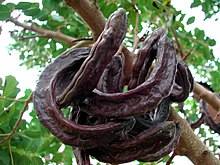Metric carat
| Physical unit | |
|---|---|
| Unit name | Metric carat |
| Unit symbol | Kt or ct |
| Physical quantity (s) | Dimensions |
| dimension | M. |
| In SI units | |
| Derived from | kilogram |
The metric carat is a unit of measurement for the mass of gemstones . 1 metric carat = 0.2 g = 2 · 10 −4 kg or 0.0002 kg.
The metric carat is not an SI unit , but is a legal unit in the states of the EU and Switzerland . It is also described in DIN 1301-1 . The carat has no legal unit symbol; in Germany the symbol "Kt" is common, in Switzerland and Austria "ct" is defined as the unit symbol.
etymology
The carat is a loan word from the French le carat from the medieval Latin carratus . This originated from the Arabicقيراط / qīrāṭ from the ancient Greek κεράτιον kerátion ( diminutive of κέρας kéras , German 'horn' ), since the fruit (pod) of the carob tree is crooked. The seeds of these fruits were often used as weights in the past. Allegedly this was due to their uniform size and weight, averaging 0.2 g. However, a study from 2006 refutes this uniformity of these seeds. According to the study, the seed mass, like that of other seeds, scatters in the range of 25%, whereas different carat figures worldwide differed by only 5%. However, test persons had the ability to recognize differences in weight of two seeds of 5%, which is why it is assumed that in addition to the seed as a unit of weight, the human ability to assess their uniformity also played a role.
history
Originally, the carat was the weight of a dried seed of the carob tree ( Ceratonia siliqua ). In the Middle Ages, one carat was the weight of three grains of barley or four grains of wheat.
Until the beginning of the 20th century, the carat was defined differently from country to country. In order to create uniformity and to get a "smooth" value in grams, the metric carat (Carat métrique) was defined with its current value in 1907 .
See also
Individual evidence
- ↑ Directive 80/181 / EEC (PDF)
- ↑ Unit Ordinance
- ↑ Lindsay A. Turnbull, Luis Santamaria, Toni Martorell, Joan Rallo, Andy Hector: Seed size variability: from carob to carats , Biol. Lett. 22 September 2006 vol. 2 no. 3 397-400, quoted from Beat Müller: Myth of the original carat refuted. Science Information Service, May 4, 2006, accessed April 19, 2010
- ^ Minutes of the 4th General Conference on Weights and Measures , 1907, p. 89, accessed on Dec. 29, 2019 (French)


